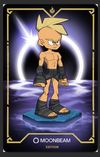Olderfall is the latest game to join the Moonbeam ecosystem — a mysterious, lore-rich RPG inspired by classics like Lord of the Rings. The team behind it came together through years of freelance collaboration, united by a mission to build something long-term and truly on-chain.

Drawing from traditional role-playing games, Olderfall Go to page https://olderfall.com/invites players into a world that unfolds chapter by chapter. Upon logging in, each player is assigned a unique avatar with distinct abilities that shape how they navigate the game. For their Moonbeam debut, the team even created a brand-new set of avatars, tailored specifically for the Moonbeam community.
In addition, Olderfall is also the first game to build using Moonbeam's game builder program iGo to page https://gamebuilder.moonbeam.network/n partnership Sequence. Taking the friction out of building, Sequence unlocks powerful tools for seamless gameplay and blockchain integration.
In this Q&A, the team dives into their creative process, their inspiration, and why Moonbeam was the ideal home for their vision.
Moonbeam: What inspired you to start building Olderfall?
Leandro from Olderfall: Olderfall emerged from the convergence of two core areas of expertise within the founding team: video game development and financial software architecture. On one side, the team had years of experience building robust, scalable tools for managing digital assets and designing secure financial systems. On the other, we had a long-standing passion for game design — creating our own games, leading dev teams, and building player-centric experiences.That combination provided a unique foundation to build a Web3 game where gameplay and economy work in harmony. From day one, the vision was to merge engaging, competitive mechanics with a transparent and sustainable on-chain economy — bringing the best of both worlds together in a way that felt natural.
Moobeam: How did your team first come together — were you friends, colleagues, or collaborators from other projects?
Leandro: The core team had worked together for years across different projects — from freelance development to building games and infrastructure for major brands. Olderfall was the natural evolution of those collaborations: a shared opportunity to create something original, long-term, and player-first.

Moonbeam: What games, genres, or stories influenced Olderfall’s world and mechanics?
Leandro from Olderfall: Olderfall takes inspiration from idle RPGs and auto-battlers — games where progression and character optimization are core to the experience. But we wanted to add more depth to management, giving each gladiator (or “Fallen”) a real identity within a hierarchy. Lore-wise, we borrowed a lot from dark, mythic universes like The Lord of the Rings and Spartacus to give the world mystery, weight, and a sense of history.
Moonbeam: For those who haven't played yet — how would you describe Olderfall in one sentence?
Leandro from Olderfall: It’s like if chess, Diablo, and a blockchain had a very competitive child.
Moonbeam: What makes Olderfall different from other blockchain-based games?
Leandro from Olderfall: It’s live, it’s playable, and it actually respects your time. You don’t need to set up a wallet or buy tokens to start playing. But if you want to go deeper, everything — from battles to upgrades — happens on-chain. Plus, our multichain identity isn’t just marketing — characters from different ecosystems have in-game meaning, and we’re constantly building ways to bring that to life.
Moonbeam: How do you approach balancing storytelling, gameplay, and on-chain mechanics?
Leandro from Olderfall: Story comes from the world, gameplay comes from strategy, and Web3 ties it all together. We don’t force blockchain into every corner — we use it where it makes sense: ownership, progression, rewards. The rest is pure game design and player psychology.
Moonbeam: Why did you choose to build Olderfall on Moonbeam?
Leandro from Olderfall: We chose Moonbeam because it’s one of the few ecosystems that shares our product-first mindset. Beyond infrastructure, they understand that user experience and sustainable growth come first — and that makes them a long-term partner, not just a tech provider.
Moonbeam: How has the Moonbeam ecosystem supported your development journey?
Leandro from Olderfall: From grants to visibility and infra partnerships, Moonbeam has been hands-on and proactive. Their support has helped us move faster — not just technically, but also in how we scale the project and reach new players.
Moonbeam: Have tools like Sequence, N3MUS, or Moonbeam’s cross-chain infra helped you unlock new gameplay possibilities?
Leandro from Olderfall: Absolutely. While we have the internal team to build most of this from scratch, integrating with tools like Sequence, N3MUS, and Moonbeam let us stay focused on gameplay and content instead of reinventing infra.
Sequence makes onboarding seamless — players don’t even know they have a wallet, and they never worry about gas fees; N3MUS gave us the tools to run competitive tournaments and live leaderboards at scale; and Moonbeam’s cross-chain capabilities give us flexibility to deploy on-chain mechanics without slowing down core development.
Moonbeam: What has surprised you the most about your player community so far?
Leandro from Olderfall: How fast they embraced the competitive aspect. Within days of launch, players were theorycrafting builds, tracking win rates, and asking for seasonal rankings.But what really blew our minds — especially in Web3 — was that players started asking for more gameplay, more activities, and more content.They weren’t just in it to earn — they wanted deeper progression and harder fights. That validated our decision to focus on game design first.
Moonbeam: Any fun stories from players or tournaments that stood out?
Leandro from Olderfall: During our first N3MUS tournament, one player — previously a regular on the leaderboard — completely vanished for two weeks. People noticed and started speculating in Discord. Then, out of nowhere, he came back and swept the entire tournament in one insane week. Turns out he’d been quietly training and prepping for a big comeback, saving all his resources for a perfectly timed push. It wasn’t something we expected — but it showed just how creative players can get when you give them systems to explore. Moments like that are a reminder that competitive games don’t just create winners — they create legends.
Moonbeam: What’s coming next for Olderfall — new seasons, characters, or mechanics?
Leandro: The next phase includes the Forge system (for crafting and NFT armors), a revamped in-game shop, chain-specific quests, and the launch of the game’s first Battle Pass. These systems are being rolled out alongside a mobile version, which will expand access to new players. All of this leads into the TGE of $AURE, followed by deeper competitive features — including guilds, seasonal leaderboards, and chain-based tournaments.

Moonbeam: Lastly, what’s your favorite in-game item, character, or moment in Olderfall?
Leandro from Olderfall: Landing a massive crit with a two-handed weapon against a fragile mage — when the screen shakes and the numbers pop — remains one of the most satisfying moments in the game. It’s a reward earned through build optimization and timing, and it captures the intensity that makes Olderfall special.
Ready to play and compete? Join an Olderfall battle here.Go to page https://moonbeam.network/games/


